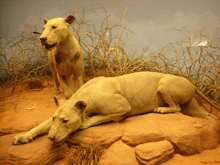According to legend, the infamous Tsavo man-eating lions dined on 135 people near a Kenyan labor camp prior to their capture in 1898. The two maneless lions have been a crowd favorite at Chicago's Field Museum, where the stuffed beasts have been on display for over 80 years.
But after analyzing fragments of the lions' bones and fur, scientists at the University of California in Santa Cruz have determined that the true number of humans eaten by the lions was likely closer to 35.
By comparing isotopes in the lions' samples with their normal prey of zebra, wildebeest and buffalo, with other lions, and with the remains of 19th century Kenyans, the scientists estimated that one of the lions ate 24 humans, while the other ate 11
[Chicago Tribune].The results suggest that the lions hunted together but didn't always share food,
which makes the pair the first example of a ...














